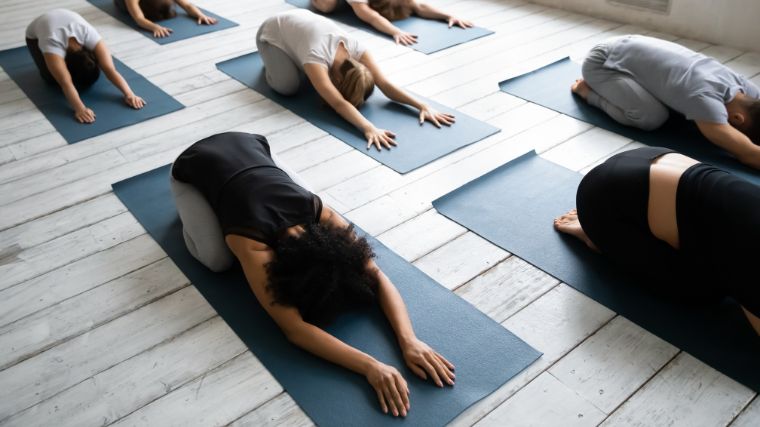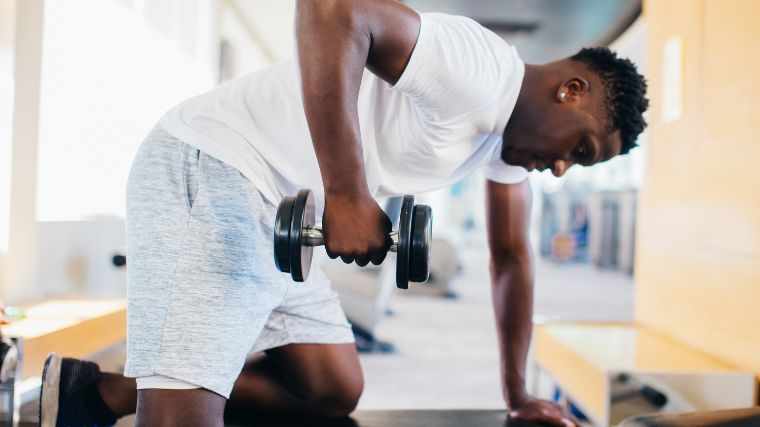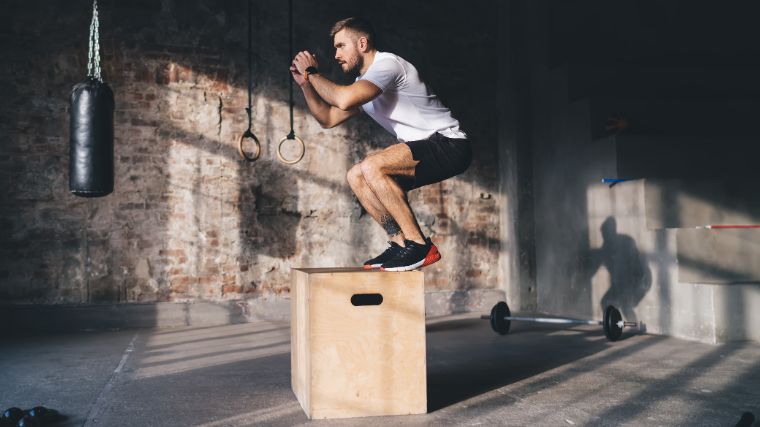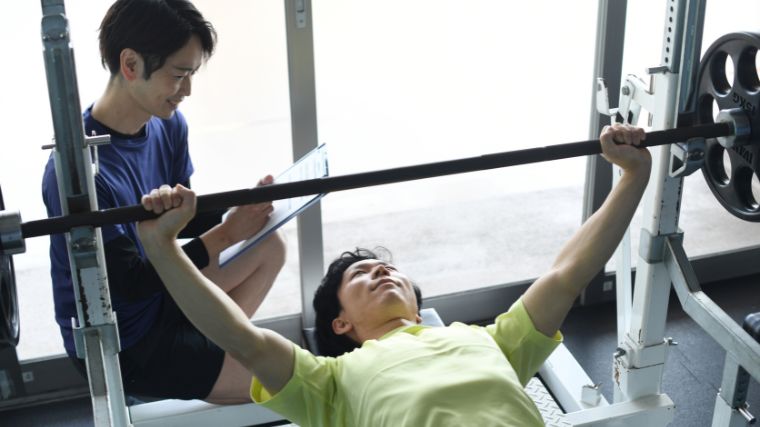Nothing worth having comes easy. This is as true in your career as it is in the gym — the latter of which can be extremely daunting if you’ve never been before.
If you’re new to exercise, hitting the gym can easily become overwhelming. After all, there are dozens if not hundreds of machines, free weights, cardio equipment, stretching tools, and more scattered around. Where do you even start?

A bit of planning and structure can make fitness less frightening and more fun. Instead of worrying over what you should be doing, how much of it, or for how long, a good beginner workout plan removes the guesswork and lets you focus on what matters; putting in the actual work. This guide has everything you need to get started, no matter your goal.
Editor’s Note: The content on BarBend is meant to be informative in nature, but it should not be taken as medical advice. When starting a new training regimen and/or diet, it is always a good idea to consult with a trusted medical professional. We are not a medical resource. The opinions and articles on this site are not intended for use as diagnosis, prevention, and/or treatment of health problems. They are not substitutes for consulting a qualified medical professional.
Best Beginner Workout Plan
All fitness enthusiasts, from recreational gym rats to full-time athletes, follow some sort of pre-programmed structure. Periodization, as it’s known, refers to the organizational design of a workout plan that ensures you’re moving toward your goals, not away from them.
Directions
You don’t need to commit to exercise every day to see results, especially as a beginner. In fact, a good three-day plan is more than enough.
You can perform these three workouts however you like over the course of a week, but remember to include at least one day of rest between workouts. For example, a common schedule is to exercise on Monday, Wednesday, and Friday.
The Workout
You may have very specific goals in mind when deciding to get active, ranging from losing weight to regaining some day-to-day mobility or building muscle.

[Read More: The Best Full-Body Bodybuilding Workout for Beginner to Advanced Lifters]
Regardless, your best bet as a beginner is to start general, developing several athletic qualities like flexibility and strength, and then get specific later on. As such, this plan is designed to improve multiple dimensions of fitness at once.
Day 1
- 5 minute cardio warm-up
- Goblet Box Squat: 3 x 8
- Assisted Pull-Up: 2 x 10
- Incline Push-Up: 2 x 10
- Plank: 3 x 15 seconds
Day 2
- 15-20 minutes of low-intensity cardio
- Kettlebell Swing: 3 x 15
- Stretching (3 rounds, 30 seconds each)
- Cat-camel stretch
- Pigeon pose
- Child’s pose
- Kneeling hip flexor stretch
- Butterfly stretch
Day 3
- 5-minute cardio warm-up
- Dumbbell Row: 3 x 8
- Barbell Bench Press: 3 x 8
- Romanian Deadlift: 2 x 12
- Box Jump: 3 x 5
How To Progress Your Workout
Here’s the deal: As a beginner, you’re going to make progress faster than you might expect (as long as you’re putting in real effort). However, that doesn’t mean that gains flow freely to ever. As you become more acclimated to the demands of exercise, you’ll need to get crafty about your workouts and incrementally increase the difficulty over time. (1)
This is known as progressive overload, and it needs to be the backbone of your workout plan long-term. Here are three simple ways to progress your workouts, organized by general priority:
Add Weight
This one applies solely to resistance training, but is the most straightforward method of employing progressive overload. If you’re performing an exercise that you can load with additional weight, such as a barbell exercise, you should strive to work with slightly heavier weights over time.

[Read More: The 15 Best Shoulder Exercises For Building Muscle]
This doesn’t mean you need to slap on 20 extra pounds every week, but you should aim to make small jumps in resistance over time.
Add Sets or Reps
If you can’t increase the amount of weight you’re lifting, your next best option is to beef up the amount of work you perform. That is, your “training volume.” The most practical way to do this is to increase the number of repetitions you perform during a set of a given exercise, or add another set altogether.
Reduce Your Rest Times
Another way to amp up the difficulty of your workouts and drive progress is to increase the density of your sessions. Which is to say adjusting the ratio of work to rest you perform.
[Read More: 5 At-Home Workouts for Strength, Muscle Growth, Power, and More]
Almost all physical activity requires brief rest intervals so you can recover for another bout of effort. Over time and as your fitness improves, you should be able to slowly chip away at these “down” periods. Resting for one and a half minutes instead of two minutes shortens your session without removing any of the actual work.
Change Exercises
Generally speaking, being a chronic “exercise hopper” is a bad thing. Adapting to any physical stressor takes time, and if you don’t give an exercise in your workout plan a fair shot, you might never find out if it’s productive for you.
That said, some scientific research has demonstrated the power of novelty when it comes to exercise. Put simply, rotating through a series of similar movements that work the same muscles may be more effective at creating progress than sticking with the same exercises for months on end. (2)

[Read More: The Best Online Workout Programs For Coaching, Cardio, Value, And More]
This doesn’t mean that you should change your workout plan on a weekly (or even monthly, necessarily) basis. However, if you’re a few months into your current routine and feel like progress is slowing down, it may be time to change up what you’re doing.
Sets and Reps Explained
Almost all physical exercise that isn’t cardiovascular endurance training is organized by sets and reps. A “rep” is a single repetition of a given exercise; think curling a dumbbell up and lowering it back down again. A “set” is a cluster of repetitions performed back-to-back with no rest in-between.
The set-rep notation you’ll see most commonly is “[sets] x [reps]”. For example:
- Biceps Curl: 3 x 8
This prescription would instruct you to perform eight biceps curls back-to-back, rest for a minute or two, and then repeat it twice more.
Workout Splits Explained
Workout splits have nothing to do with ballet, yoga, or gymnastics — unless you’re training for flexibility, of course! A “split” is a colloquial term for the general organization behind a workout program.
In real-world terms, splits define the number of days you hit the gym and what you do on those days. For example, a three-day workout split involves exercising thrice per week. People will also commonly design splits around training specific muscle groups (prevalent in bodybuilding) or anatomical functions (think pushing and pulling).

[Read More: Best Treadmills For Streaming, Folding, Running, And More]
There are also full-body splits, which entail performing a variety of exercises for your entire body multiple times throughout the week. These principles apply to all forms of physical activity: You can have a workout split that contains cardio, stretching, sport-specific practices, and so on. Splits are simply your schedule.
Beginner Workout Tips
When it comes to separating an average workout from an exceptional one, the devil’s in the details. Getting yourself into the gym or off the couch is half the battle, though. Once you’ve committed to taking the plunge, put these simple tips into practice to enhance your results:
Start Slowly
The fastest runners in the world didn’t start their training with sprints; they started with jogs. To be successful in any athletic endeavor, especially if you’re new to physical activity, you’ll need to pace yourself. After all, you have to crawl before you can walk.
[Read More: The 15 Best Home Gym Machines]
In real-world terms, this looks like selecting very easy weights during your first few sessions. Don’t be afraid to take ample rest time between sets, or ask a staff member at the gym to advise you on proper technique rather than trying to wing it on a complicated exercise.
Dress Appropriately
The saying “look good, feel good” absolutely applies to the gym. Not only will appropriate gymwear help wick sweat and cool your body, you’re more likely to put in a higher amount of effort during your workouts if you’re rocking a killer outfit.
Bring Music (Or a Friend)
As it turns out, your favorite tunes are good for more than jamming out on the drive to the gym. There’s some interesting science behind auditory stimulation and exercise performance.

[Read More: The Gymgoer’s Guide to Whey Protein]
Namely, some data has shown that listening to music during exercise can improve pain tolerance, increase motivation, and even boost your strength in some cases. (3)(4) A similar idea applies to working out with a partner. You’ll have a reliable and trusted spotter to help you stay safe while you train, and you’ll also have someone to trade motivation with on your journey.
Don’t Aim for Perfect
One of the worst things you can do as a beginner on their fitness journey is to obsess over “optimal.” In almost all cases, simply making it into the gym at all is a victory, and will get you closer to your goals than not going at all out of fear of not doing things properly.
When you’re starting out, don’t be afraid to head into the gym and do things wrong. You won’t master a new exercise during your first session, and that’s okay. Over time, many slightly-less-than-perfect sessions will get you much further than a few “perfect” workouts.
FAQs
If you’re still wondering about working out, we’ve got you covered. Check out these common questions, answered for your convenience:
What is a good beginner workout routine?
Realistically speaking, a good beginner workout routine is one that you find enjoyable and can stick to. The perfect workout plan doesn’t exist, and forcing yourself to partake in a type of activity you detest isn’t sustainable.
That said, most beginners should focus on exercising between two and four days per week, performing a combination of different activities including strength training, cardiovascular exercise, and stretching or balance-focused drills.
How many days should a beginner workout be?
One of the best parts of being a beginner on your fitness journey is that you can get a lot out of a little. As in, you need very little physical training to make substantial progress as long as you put in real effort.
Most beginner workout routines consist of two to four days of planned activity. That three-day sweet spot ensures that you’re moving regularly, but also have ample time to rest and recover as you adjust to the demands of exercise.
What are the benefits of working out?
The list of benefits of working out is almost endless. Physical activity is demonstrably and consistently associated with improved health markers like mood, blood pressure, heart rate, body composition, joint stability, and much, much more. (5) Exercise is, indisputably, the most effective non-medical care you can provide to your body throughout life.
More Training Content
- The Ultimate Guide to Building Your Own Bodybuilding Workout Plan
- How to Balance Running and Strength Training, No Matter Your Goals
- Build Muscle Anywhere With These At-Home Workouts
References
- Williams, T. D., Tolusso, D. V., Fedewa, M. V., & Esco, M. R. (2017). Comparison of Periodized and Non-Periodized Resistance Training on Maximal Strength: A Meta-Analysis. Sports medicine (Auckland, N.Z.), 47(10), 2083–2100.
- Fonseca, R. M., Roschel, H., Tricoli, V., de Souza, E. O., Wilson, J. M., Laurentino, G. C., Aihara, A. Y., de Souza Leão, A. R., & Ugrinowitsch, C. (2014). Changes in exercises are more effective than in loading schemes to improve muscle strength. Journal of strength and conditioning research, 28(11), 3085–3092.
- Silva, N. R. D. S., Rizardi, F. G., Fujita, R. A., Villalba, M. M., & Gomes, M. M. (2021). Preferred Music Genre Benefits During Strength Tests: Increased Maximal Strength and Strength-Endurance and Reduced Perceived Exertion. Perceptual and motor skills, 128(1), 324–337.
- Thakare, A. E., Mehrotra, R., & Singh, A. (2017). Effect of music tempo on exercise performance and heart rate among young adults. International journal of physiology, pathophysiology and pharmacology, 9(2), 35–39.
- Ruegsegger, G. N., & Booth, F. W. (2018). Health Benefits of Exercise. Cold Spring Harbor perspectives in medicine, 8(7), a029694.
Featured Image: Jono Erasmus / Shutterstock